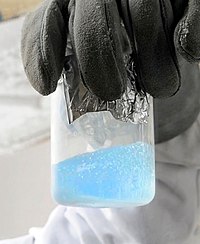
Photo from wikipedia
A series of meso-substituted with aromatic (=tolyl, pyrenyl, fluorenyl, naphthyl, and triphenylamine) substituents, platinum (Pt), and palladium (Pd) porphyrins have been synthesized and characterized by spectroscopic and single-crystal X-ray diffraction… Click to show full abstract
A series of meso-substituted with aromatic (=tolyl, pyrenyl, fluorenyl, naphthyl, and triphenylamine) substituents, platinum (Pt), and palladium (Pd) porphyrins have been synthesized and characterized by spectroscopic and single-crystal X-ray diffraction studies to probe structure-reactivity aspects on the electrochemical redox potentials, and phosphorescence quantum yields and lifetimes. In the X-ray structures, the aromatic meso-substituents were rotated to some extent from the planarity of the porphyrin ring to minimize steric hindrance. Both Pt and Pd porphyrins revealed higher electrochemical redox gaps as compared to their free-base porphyrin analogs as a result of the harder oxidation and reduction processes. The ability of both Pt and Pd porphyrins to generate singlet oxygen was probed by monitoring the photoluminescence of 1 O2 at 1270 nm. Higher quantum yields for both triplet sensitizers compared to their free-base analogs were witnessed. Singlet oxygen quantum yields close to unity were possible to achieve in the case of Pt and Pd porphyrins bearing triphenylamine substituents at the meso-position. The present study brings out the importance of different meso-substituents on the triplet porphyrin sensitizers in governing singlet oxygen quantum yields; a key property of photosensitizers needed for photodynamic therapy, chemical synthesis, and other pertinent applications.
Journal Title: ChemPlusChem
Year Published: 2022
Link to full text (if available)
Share on Social Media: Sign Up to like & get
recommendations!